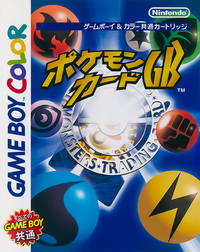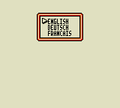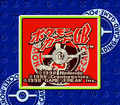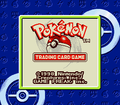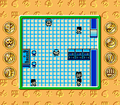Pokémon Trading Card Game (video game)
- This article is about the Game Boy game. For other TCG video games, see Category:Pokémon Trading Card Game video games.
| Pokémon Trading Card Game ポケモンカードGB | |
|---|---|
 Boxart of Pokémon Trading Card Game | |
Basic info
| |
| Platform: | Game Boy Color*, Nintendo 3DS (Virtual Console) |
| Category: | Strategy |
| Players: | 2 players simultaneous |
| Connectivity: | Game Link Cable, Infrared |
| Developer: | Hudson Soft |
| Publisher: | Nintendo |
| Part of: | Generation I side series |
Ratings
| |
| CERO: | A |
| ESRB: | E |
| ACB: | G |
| OFLC: | G8+ |
| PEGI: | 3 |
| GRAC: | N/A |
| GSRR: | N/A |
Release dates
| |
| Japan: | December 18, 1998 (GBC)[1] December 24, 2014 (3DS VC)[2] |
| North America: | April 10, 2000 (GBC)[3] November 13, 2014 (3DS VC)[4] |
| Australia: | April 7, 2000 (GBC)[5] July 11, 2014 (3DS VC)[6] |
| Europe: | December 15, 2000 (GBC)[7] July 10, 2014 (3DS VC)[8] |
| South Korea: | N/A |
| Hong Kong: | N/A |
| Taiwan: | N/A |
Websites
| |
| Japanese: | Official site |
| English: | Official site |
|
Japanese boxart
| |
Pokémon Trading Card Game (Japanese: ポケモンカードGB Pokémon Card GB) is a Pokémon spin-off video game for Game Boy Color based on the card game Pokémon Trading Card Game. Despite being a Game Boy Color game, it can also be played on the original Game Boy, but with some features disabled. It was released in Japan on December 18, 1998, North America on April 10, 2000, Europe on December 15, 2000, and Australia on April 7, 2000.
In 2014, the game was rereleased worldwide on Nintendo 3DS via the Virtual Console service, and discontinued on March 27, 2023 due to the e-shop shutdown. During the February 8, 2023 Nintendo Direct, it was announced that the game would be included as part of the Nintendo Switch Online library of Game Boy games.
Pokémon Trading Card Game was followed by a Japan-exclusive sequel, Pokémon Trading Card Game 2: The Invasion of Team GR!
Copies of the Japanese version included a promotional Dragonite card, whereas copies available outside Japan included a promotional Meowth card.
Plot
The player begins their adventure at Mason Laboratory, where Dr. Mason gives the player the choice of taking along one of three different Pokémon Trading Card Game decks: Charmander & Friends, Squirtle & Friends or Bulbasaur & Friends.
The player character, Mark, has an ambition of becoming the world's greatest Pokémon Trading Card Game player, but his rival, Ronald, has a similar goal. Ronald duels the player at certain points in the game to test the player's cards; being defeated by Ronald is an indication for the player to improve his or her deck, whereas victory results in the player receiving a Promotional Card.
The object of the game is to defeat eight Club Masters (comparable to the Gym Leaders), earn their Master Medals (comparable to Badges), and then defeat four Grand Masters (comparable to the Elite Four) and the Champion. The Club Masters' decks correspond to the types of Trading Card Game cards; however, because there are eight Club Masters but only seven distinct types in the game, two of the types are repeated: Fighting and Grass, split in the form of a "Rock" and a "Poison" user, respectively.
Blurb
Based on the hit Wizards of the Coast card game...
The greatest Pokémon Trading Card Game players of all time – the Grand Masters – are looking for one player worthy of inheriting the four rare, Legendary Pokémon Cards! Build new decks with the Auto Deck Machine, hone your skills on the Challenge Machine and test your ability in Challenge Hall. Expand your card collection, duel your way through 8 Club Masters and earn the right to challenge the Grand Masters in the Pokémon Dome! Shadowy figures, wise instructors and powerful opponents await in the ultimate trading card game adventure!
- Includes over 200 of your favorite Pokémon Trading Cards, plus new cards exclusive to the Game Boy game!
- Learn how to play the card game, build and manage decks and duel with other card players in step-by-step tutorials.
- Duel a friend using the Game Link cable (sold separately) or generate new cards using the Infra-Red Card Pop! feature (available with Game Boy Color only).
- Basic reading skills are needed to fully enjoy the story.
Features

Overworld
- The "Deck" option in the menu can be used the manage the player's decks. There is also a Deck Save Machine where the player can save custom deck configurations.
- The PC can be used to view a list of cards owned.
- Each Club has a Battle Center and a Gift Center. The Battle Center allows dueling against other players via Game Link Cable. The Gift Center allows sending and receiving cards and deck configurations to and from other players.
- The player status screen displays the player's name, the number of non-repeated cards owned, their play time, and their Master Medals (similar to the Trainer Card in the core series games).
- The player saves by writing on a Diary (similar to the Japanese version of the core series games, where the player writes in a Report). The player's location is displayed on the main menu before loading a save file.
- The player can run by pressing B. (This feature was later used in the core series games with the debut of the Running Shoes in Pokémon Ruby and Sapphire.)
- Dr. Mason sends the player e-mails over the course of the game, sending fifteen in total. Each message contains at least one booster pack.
- There are ten Auto Deck Machines which allow the player to build predefined decks if they have the corresponding cards. One is available from the beginning, eight require Master Medals (one Master Medal for each machine) and the other is found at the end of the game.
- There is the Challenge Cup tournament held in the Challenge Hall, where the winner receives rare Promotional Cards.
Duels
- Main article: Duel (TCG GB)
- The duel screen shows only one Pokémon card on each side of the field at once, displaying its name, HP, and number of Energy cards. Additionally, the number of cards in the deck and on the Bench are also displayed.
- Various commands are found below the duel scene.
- When the player wins a duel, they usually receive two booster packs. Winning against the rival Ronald awards a Promotional Card instead.
- If the Game Boy console is turned off or loses power during a duel, the option to Continue from Duel will be available on the main menu when the game is next played, allowing the player to resume from the start of the turn on which the game was halted.
- This saved data is automatically erased once the player has selected to restart the duel, or if they choose to Continue from Diary.
- The option to Continue from Duel can also sometimes be available if the Game Boy console is turned off or loses power shortly after a duel is completed, and the player did not write in their Diary after completing the duel. When this occurs, the game will resume from the final turn of the previously completed duel.
Clubs
There are eight Pokémon Clubs on Trading Card Game Island, each with their own type affiliation. Three different Club Members duel the player inside each Pokémon Club. The Club Masters are Nikki (Grass), Rick (Poison), Ken (Fire), Amy (Water), Isaac (Lightning), Murray (Psychic), Gene (Rock) and Mitch (Fighting).
Grand Masters
There are four Grand Masters located at the Pokémon Dome. The Grand Masters are Courtney (Fire), Steve (Lightning), Jack (Ice) and Rod (Dragon); the Champion is Ronald, who has a deck of mixed types.
Pokémon cards
- Main article: Card (TCG GB)
The game contains every card released in the real Trading Card Game's Base Set, Jungle, and Fossil expansions, except for the Base Set's Electrode and Fossil's Ditto. (This only includes cards released in the Japanese expansions, so no normal counterparts of Holofoil cards are included.) Additionally, the first 14 tournament-legal Unnumbered Promotional cards are included (not counting glossy/non-glossy reprints). The game also features 18 game-exclusive cards which weren't produced for normal play, though some were released later on. The game emulated the experience of the actual Trading Card Game very closely.
The game contains the data for 228 cards. Despite this, not all Pokémon are available to the player through normal gameplay; Card Pop! must occur between players in order to complete their album without the use of cheats.
Cards can be obtained through booster packs from four expansion sets including Colosseum, Evolution, Mystery, and Laboratory, or by defeating specific challengers (for example, each defeat of the Grand Masters will award the player with a set of Legendary Moltres, Zapdos, Articuno, and Dragonite cards). Among the aforementioned four expansion sets is a fifth set, the Promotional Card set. However these cards can only be attained by defeating players such as Ronald, Imakuni?, and the Grand Masters, defeating three Challenge Hall opponents in a row, trading with Ishihara, and Card Popping.
Connectivity
Pokémon Trading Card Game allows players to send and receive cards and deck configurations or perform a Card Pop! between two cartridges via infrared. The Japanese cartridge has a built-in infrared feature, while the American and European versions use the infrared communications port of the Game Boy Color.
Pokémon Trading Card Game allows players to duel each other using their own decks via the Game Boy Game Link Cable.
Pokémon Trading Card Game cannot communicate with Pokémon Trading Card Game 2: The Invasion of Team GR!. All multiplayer features are disabled in the Nintendo 3DS Virtual Console release.
Card Pop!
- Main article: Card Pop!
Card Pop! is a two-player feature that randomly generates a card for each player. When the infrared ports of two Pokémon Trading Card Game cartridges are connected, each player will receive a random card. A player cannot Card Pop! with the same game again until both players have used the feature with so many others that their partner's ID is overwritten in both games. This feature is the only way of obtaining the Phantom Cards Mew and Venusaur.
Card Pop! cannot be performed between Pokémon Trading Card Game and Pokémon Trading Card Game 2: The Invasion of Team GR!. Attempting to do so can result in glitches such as a game freeze or a loss of save data in Pokémon Trading Card Game.
Regional differences
European languages
There are two European versions of this game, each with three languages. One of them is playable in English, French, and German. The other is playable in English, Italian, and Spanish. When the player boots either of the European versions for the first time, the list of languages appears before the game starts. The list of languages is also available at the options screen.
This screen appears when the player boots the game for the first time:
Graphics
- The Booster packs seen in the intro cutscene had their design changed between localizations. This was done to reflect the artwork used by each booster pack by region.
- The title screen was changed between the Japanese and international releases.
- The Super Game Boy border in international releases removes the writing of Pocket • Monsters • Trading • Card • Game • on the Poké Balls.
- The back of Pokémon cards was changed in international releases to the design used on the back of cards outside of Japan.
- The international releases refined the graphics for the Game Boy consoles seen when using the various link features, such as Card Pop!.
- In the Japanese version, the symbol for a paralyzed Pokémon are two vertical jagged lines (
 ). In the American and European versions, the symbol is a horizontal jagged line (
). In the American and European versions, the symbol is a horizontal jagged line ( ). Possibly due to the former’s resemblance to the Schutzstaffel symbol.
). Possibly due to the former’s resemblance to the Schutzstaffel symbol. - The artwork for Jynx's face was changed from black to purple in international releases to avoid further controversy. This card was later further changed in the Virtual Console release, with the purple background being lightened some more.
- When the player tries to save an unnamed deck in the Japanese version, the player name is included in the default deck name. In all other languages, the player name is not included. For instance, if the player is named "パーク" (Park) in the Japanese version, the first default name used for an unnamed deck is "パークの001デッキ" (Park's 001 Deck). In the English version, the first default name is simply "001 Deck"
Virtual Console differences
This release is locked in Game Boy Color mode; it cannot be played in Game Boy monochrome mode or with the Super Game Boy borders.
Due to the Nintendo 3DS not emulating Game Link functionality (infrared and the Game Link cable), several features were disabled in the Virtual Console release.
Card Pop! is disabled, making the two Phantom Cards unobtainable and the Mysterious Pokémon Deck impossible to obtain normally. The Mysterious Pokémon Deck is still included in the Legendary Auto Deck Machine in certain versions of the Virtual Console release, making the Legendary Auto Deck Machine the only possible way to see those cards. Due to Card Pop! being disabled, a bookshelf in Mr. Ishihara's House is disabled, as the bookshelf refers to the Phantom Cards from Card Pop!.
Due to Game Link cable functions being disabled, clerks at Clubs who would normally be spoken to for the Battle Center or Gift Center do not interact with the player.
Due to this release lacking compatibility with the Game Boy Printer, the "Print" function, which is accessible from PCs, has been disabled.
On the region-locked Nintendo 3DS, J region systems can only access the Japanese version of the game, U region systems can only access the English version of the game (despite being able to access multiple languages of the Generation I and II core series games), and E region systems can only access the English-French-German version of the game. The English-Italian-Spanish version released for the Game Boy Color in Europe was never released on the Nintendo 3DS.
Staff
- Main article: Staff of Pokémon Trading Card Game
Gallery
Title Screen
Super Game Boy borders
This game is interesting in that there are two different SGB border: the title screen one, and the one used during gameplay. Moreover, the latter also gains a special golden palette after beating the game at least once.
Unused Border
- Pokemon TCG JP Unused SGB Border 2.png
Unused border (Japanese)
- Pokemon TCG International Unused SGB Border 2.png
Unused border (International)
Trivia
- The promotional Venusaur card that appears in the game (and can only be obtained by using Card Pop!) was included with the Pokémon Trading Card Game: Official Nintendo Player's Guide in North America and with the Pokémon Card GB Official Guidebook in Japan.
- The Surfing Pikachu with artwork featuring Mt. Fuji and a bullet train was released in Japan but not in English. The card was printed in English, but never with that artwork.
- This game, along with its sequel, are the only spin-off games to share overworld sprites with the, at the time, core series games.
- In the American version, the two available Ninetales cards (the card from Base Set and the card exclusive to Game Boy) have their name misspelled as Ninetails. However, the correct name "Ninetales" is found in the description of Base Set Ninetales's Fire Blast attack. This was fixed in the European versions.
- The internal files of the game contain an unused Super Game Boy border, which was used for testing purposes.[9]
- In the American version, the game text is displayed in all-caps in normal play. However, the characters are internally stored in mixed case.
- Specifically, the character encoding for letters and numbers is the same as ASCII (which is mixed case), except for some special characters such as "É". There are also various other characters added for special symbols.
- In the internal game data of the American version, there are some words written in all-caps, including some character names and Pokémon species such as "Grand Master COURTNEY" and "SQUIRTLE & Friends Deck", but at other times they are inconsistently stored in mixed case such as "Courtney" and "Squirtle" nonetheless.
- Some abbreviations are exceptions, shown in mixed case in all games, such as "Lv" and "No" on Pokémon cards. In Japanese and some European languages, m (meters) and kg (kilograms) are also displayed in lowercase.
- In the European versions, the game text is not only displayed, but also internally stored in all-caps. The codepoints for ASCII small letters are instead used to display some special characters and letters with diacritics, such as Á, Ñ, and Ü.
External links
- Pokémon Trading Card Game (GBC) - Nintendo.co.jp (Japanese)
- Pokémon Trading Card Game (3DS) - Nintendo.co.jp (Japanese)
References

|
This article is part of both Project Sidegames and Project TCG, Bulbapedia projects that, together, aim to write comprehensive articles on the Pokémon Sidegames and TCG, respectively. | 
|
